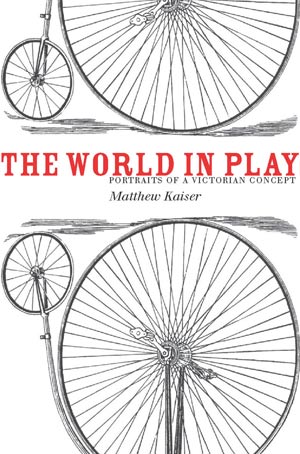
The most compelling and unsettling moment for me in all of Victorian literature comes when Alice tumbles down the rabbit hole: that epistemological abyss at the heart of nineteenth-century modernity. For all its quaintness, it is a terrifying image. A ludic microcosm swallows reality whole. The boundary between the inside of the child’s game and the outside schizophrenically collapses. Modern life, in the shape of a girl, loses its footing.
In this book, I lower myself into the rabbit hole. I survey and map it. I explore the extent to which a growing number of nineteenth-century British writers and thinkers equated modern life with the sensation of a world in play. A world in play means two things. It means a world in flux, an unstable cosmos with an unfixed horizon, a universe turned inside out. But it also means a world trapped in a ludic representation of itself, a world literally inside play.
The further I made my way down this Victorian rabbit hole, the more startled I was by the ubiquity of the logic of play in nineteenth-century depictions of modernity, indeed, the centrality of play to the Victorian sense of self. Darwin, for instance, conceives of nature, including human nature, as a competitive sport, with biological winners and losers. Rudyard Kipling rechristens British imperialism the “Great Game.” The Victorians invented the weekend. They turned leisure into big business. They built hundreds of parks and playgrounds in a normalizing effort to cultivate and manage play. Child play acquired unprecedented ideological importance in the nineteenth century. In myriad ways, the logic of play made the Victorian world cohere. From the middle-class ethic of competition, through the therapeutic faith in recreation, to the political efficacy of holidays in the promotion of national identity, play made everyday life make sense. At the same time, however, this intrinsically unstable concept betrayed the illusoriness of life’s coherence.
The idea of a world in play is not the same thing as a world at play, which is how the Victorians depicted that apocryphal epoch known as “Merry Old England.” A world in play is not about having fun. It is about being trapped in the funhouse mirror, in illusion, in an unsettling new reality in which “all that is solid,” to quote Marx and Engels, “melts into air.” Our twenty-first-century fascination with virtual reality, artificial intelligence, and online communities, with dystopian computer programs that colonize consciousness itself, can be traced to the Victorian world in play. In The Matrix, Alice-like Neo follows a woman with a rabbit tattoo down a digital hole.
This book maps the Victorian world in play—and hence our own. In the process, it advances a new theory of Victorian literature and culture. But the book also examines how various Victorian writers—Charles Dickens, Emily Brontë, Robert Louis Stevenson, Oscar Wilde, among others—struggled valiantly to find their footing, ethically and politically, in play, how they made a home for themselves in this unsettling world of ours.
My motivations for writing this book were largely historical and aesthetic. I wanted to explain the proliferation of various tropes of play in Victorian literary representations of modern life. Even though they are often portrayed in popular culture as earnest, stuffy, and unplayful, the Victorians were more anxious about play, than they were openly hostile to it. As J. Jeffrey Franklin has argued, play was a “linch-pin concept” in nineteenth-century Britain. It performed important ideological work. The Victorians took play seriously.
So much of the tension in Victorian literature, in fact, lies within play, among its various senses, not between play and its conceptual antitheses. Scrooge’s miserliness, for instance, is just as pervasively marked by play as Tiny Tim’s mirth. Scrooge embodies competition, the agonistic impulse to win. He views life as a contest. Far from being a protest against spoilsport modernity, against Victorian unplayfulness, Dickens’s A Christmas Carol can be read as an account of the civil war raging within the concept of play, in this case, between middle-class competition and plebeian festivity. Dickens understood that play has no conceptual outside. It has swallowed reality.
I had another, more mischievous and methodological, reason for writing this book. Having been influenced by the groundbreaking work of play theorists Gregory Bateson and Brian Sutton-Smith, I set out to build an interdisciplinary bridge between play studies and Victorian studies. I wanted to provide readers with the first comprehensive ludic theory of nineteenth-century British culture. The book, therefore, was written in a spirit of adventure and risk. It is the first word on the subject, not the last. My hope is that readers will expand and complicate my paradigm, explore new dimensions to the world in play. I built the bridge, but others must reinforce it, make it their own.
Oscar Wilde—the subject of my concluding chapter—is the true hero of the book. Were a reader to read only one chapter, it should probably be my chapter on Wilde, for he has the best solution to the dilemma of how one survives and thrives in a world in play. We tend to think of witty, charismatic Wilde, who was arrested in 1895 and imprisoned for homosexual offenses, as a ludic martyr in a tragically unplayful age. He made the middle-class world laugh at itself. That world responded by crushing him. That is what we have been taught. The truth, however, is far more complicated.
What made Wilde so controversial was his refusal to take play seriously or show it the proper respect. He was a spoilsport. He mocked the cult of athleticism that pervaded all aspects of Victorian middle-class life. Wilde famously quipped that the only outdoor sport he played was dominoes “outside French cafés.” He delighted in undermining manly competition, loving his competitor, instead of competing with him. Wilde’s critique of earnestness derived, in fact, from his mischievous ethic of anti-athleticism, for etymologically the word “earnest” means “struggle” or “contest,” a tedious and righteous impulse to win every battle, to be the best.
Wilde found beauty and pleasure in loss. He viewed the athlete’s muscular body as an end in itself, not as a tool with which to defeat another man. There is something profoundly Christian in Wilde’s renunciation of all things agonistic, his willingness to lose, his celebration of loss as a virtue. His Victorian contemporaries viewed modern life as a brutal contest from which there was no escape. The only ethical answer, Wilde concluded, in the spirit of the holy fool, was to play to lose, to choose not to want to win this soul-crushing game. Therein lies the art of love.
Admittedly, The World in Play is a counterintuitive book. It advances a controversial new theory—an upstart theory—of nineteenth-century modernity. Some readers will be resistant. The book questions many longstanding assumptions about Victorian culture. Sacred cows were undoubtedly injured along the way.
But there is one sacred cow that deserves to be, if not killed, at least roughed up. The World in Play is a warning to those who would protect this creature. What is it? We literary critics, we academic children of Schiller, Derrida and Bakhtin, tend to associate play with all things good and worthy: with epistemological subtlety, with political freedom and subversion, with psychological complexity and aesthetic novelty, indeed, with culture itself. We recoil instinctively from the notion that play might be politically suffocating or emotionally constricting. The thought depresses us. Play, after all, has become inextricably linked over the last two centuries with the logic of art. Let’s not idealize play. We must resist the temptation. In this book, I cast myself—as I do in all my work—as Devil’s Advocate. I provide an alternative, less utopian vision of play. I expose its dark side.


Matthew Kaiser is Associate Professor of English at Harvard University, where he teaches courses on Victorian literature and gender and sexuality to one thousand students annually. He is the author of The World in Play, featured on Rorotoko, and of work that has appeared in a variety of journals and essay collections, and the editor of five books: Alan Dale’s A Marriage Below Zero, Leopold von Sacher-Masoch’s Venus in Furs, Philip Meadows Taylor’s Confessions of a Thug, and the two-volume Crime and Horror in Victorian Literature and Culture. Matthew Kaiser is currently at work on a book about the neurophysiology of historical consciousness titled Anatomy of History: Cognitive Neuroscience and the Victorian Sense of the Past.